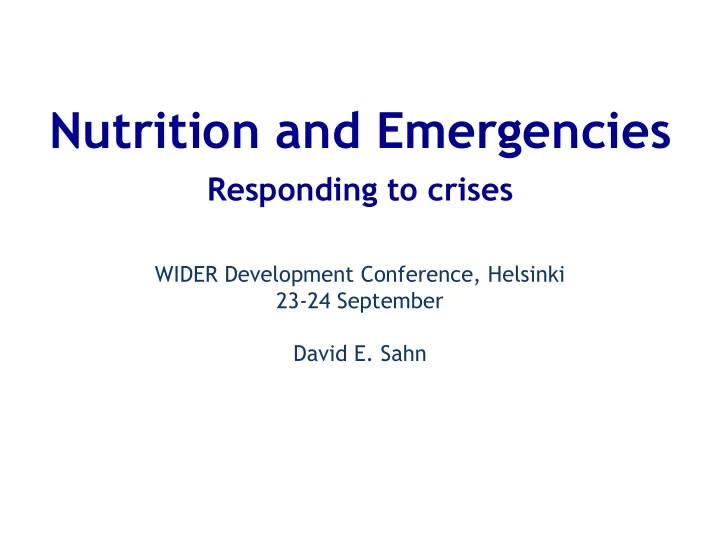

Nutrition and Emergencies Responding to crises WIDER Development Conference, Helsinki 23-24 September David E. Sahn
HISTORICAL EVOLUTION OF NUTRITION EMERGENCIES • 19 th century: Malthus ( 1798) wrote of inevitability of massive famines • Mid-20 th century: great famines in Asia (India; China 1958 killed 30 million) – Erlich (1968) echoed ideas of Malthus – However, Sen (1981) introduced capabilities approach and entitlement failures to understand human deprivation and famine • Late-20 th century: Africa famines induced by drought (e.g., 1 million death in Ethiopia mid 1980s)
HISTORICAL EVOLUTION OF NUTRITION EMERGENCIES • 21 st century: refugees and displaced persons in failed states • In 2015 65.3 million people (51% of whom are children)displaced: • 1 in 113 worldwide displaced by conflict/persecution. Why so many? – Long lasting and persistent conflicts, e.g., Somalia and Afghanistan – New conflicts past 5 years: e.g., South Sudan, Ukraine, Syria • Addressing needs of internally and increasingly internationally displaced persons increasingly involved: – diminished role for, and interest of state and formal sector institutions – more reliance on NGOs and indigenous institutions
NEW URGENCY IN NUTRITION EMERGENCIES • Donor funding for emergency nutrition programs much greater than non-emergencies, and growing rapidly in magnitude unlike non-emergency funding – e.g., children <2 years receiving special nutritionally enhanced food products from WFP emergency ops increased from 55,000 to 4 million from 2008 and 2013 • Recognition and concern that that emergency programs receive far less scrutiny in terms of evaluation and economic analysis of what works and program impact.
IMPORTANT DIMENSIONS OF EMERGENCIES • Prominence and visibility, and related humanitarian response covers a wide range: – some acute catastrophic events are highly visible; others are low-visibility/unheralded emergencies that receive little international attention • Duration: short-term acute; chronic protracted • Internal stable population or internationally displaced • Degree of destruction of systems and infrastructure – e.g., short-terms draught versus nature disaster that destroys roads, houses, water systems, etc.
Distinction between emergencies and non-emergencies • Most important distinction are in terms of time dimension – suddenness – and espoused goals of response – emergencies: reduce short-term mortality and life- threatening malnutrition at all costs; – chronic malnutrition: promote sustainable and evidence- based approaches, considering opportunities costs, negative (and positive) externalities, priority setting, etc. • Emergencies becoming longer in duration and chronic in nature
Distinction between emergencies and non- emergencies becoming blurred • Both caused by – Disruptions of food production and supply chain – Loss of livelihoods – Drought, floods and environmental crises -- climate change and ecological disasters – Epidemics and new disease vectors, e.g, HIV, ebola – Acute poverty due to economic shocks and crisis – Inability to provide basic curative and preventative health care, water and sanitation – Disruptions in food supply chain – Poor care and feeding practices
COMMON MANIFESTATIONS • Wasting (acute malnutrition) and stunting • Micronutrient deficiencies • Low birth weight • Diarrhea and other infectious and communicable disease • Obesity?
Distinction between emergencies and non-emergencies • Invariably short/long terms goals merge: – achievement of longer term goals prevents or mitigate impact of emergencies • better nourished children more resilient – emergencies transform into longer term challenges and chronic malnutrition • lowers human capital through school dropout, loss of savings, etc • destroy institutions and infrastructure, and sources of livelihoods • food aid and sedentary lifestyles in refugee camps can contribute to obesity
Distinction between emergencies and non- emergencies • LACK OF EMPIRICAL STUDIES AND EVIDENCE-BASED APPROACHES TO NUTRITION EMERGENCIES – scale and urgency of need • Economist not good at evaluating large programs on short notice – perception that any response a good response – dominated by humanitarian concerns that neglect or reject concerns about best practice and adverse unintentional consequences – challenges of collecting data, metrics and other causal analysis that links interventions with outcomes such as reduced mortality – great diversity of contexts and complexity often not fully understood • externally validity difficult to show
Future Challenges • What is role of economic policy research – traditional areas for evidence based economic research, including program evaluation, are far more limited in scope than for dealing with chronic nutrition problems • no time to set up RCTs • lack of observational and baseline data and other sources of model identification, such as good instruments. continued
Future Challenges – many research questions fall in other spheres • operations research focusing on logistics, delivery systems and scale up of programming • tools for surveillance and early warning systems • bio-medical issues such as appropriate ration sizes and therapeutic foods and ready-to-use for acutely malnourished infants and children • messaging and behavioral change • politics and conflict studies
Future Challenges • Chronic malnutrition (stunting and micronutrient deficiencies) represent a silent emergency, greater in scope than acutely malnourished – 169 million, or approximately 30 percent of children under < 5 are stunted • Facing competition for resources since perception is that emergencies can’t wait, but chronic malnutrition can • Addressing these problem requires first dealing with humanitarian crises continued
Recommend
More recommend